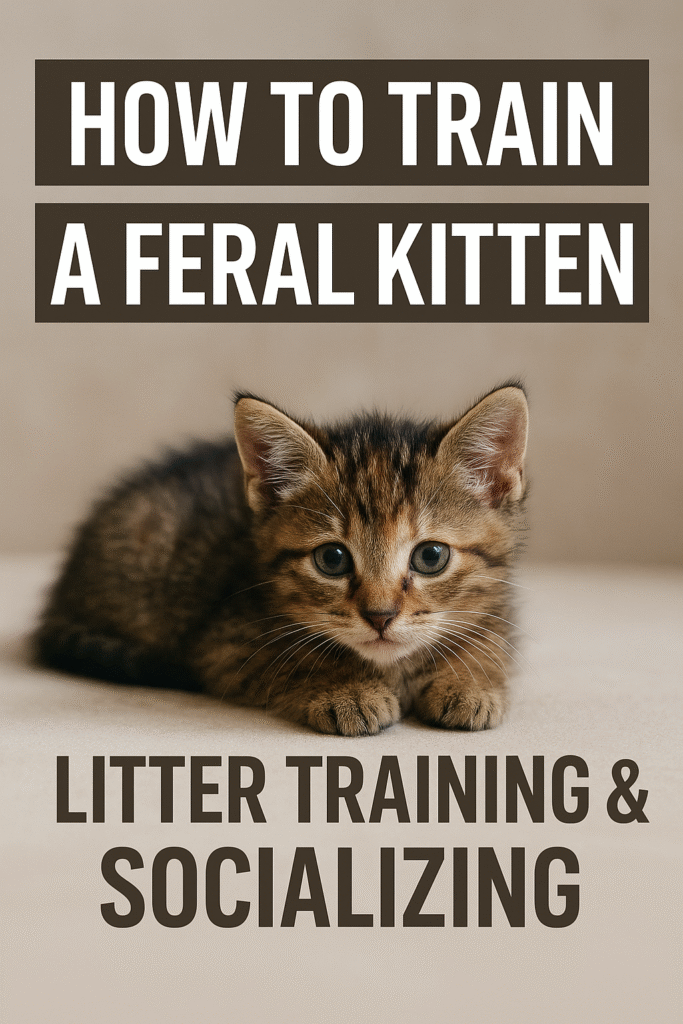Post Disclaimer
Catopedea shares information for educational and general interest purposes only. Our content is not a substitute for professional veterinary advice, diagnosis, or treatment. Always consult a licensed veterinarian for concerns about your cat’s health, diet, or behavior.
Feral kittens may look like any other playful little cat, but their early life experiences make them very different from house-raised kittens. Because they were born outdoors with little to no human contact, feral kittens are usually fearful, cautious, and may not understand basic behaviors that pet cats pick up naturally like using a litter box.
If you’ve rescued a feral kitten, you may be wondering: Can feral kittens really learn to use a litter box? The answer is yes with patience, the right setup, and consistency, most feral kittens can be trained successfully.
In this guide, we’ll cover everything you need to know about how to train a feral kitten to use a litter box, step by step. We’ll also dive into common mistakes, troubleshooting tips, and even real-life examples to make the process easier.

Why Training a Feral Kitten Is Different
Unlike indoor kittens raised by pet cats, feral kittens:
- Are not accustomed to humans and may be afraid of handling.
- May have learned to eliminate outdoors in dirt or grass.
- Often feel stressed in enclosed spaces or when exposed to unfamiliar smells.
- Need to overcome fear before they can learn new habits.
This doesn’t mean they can’t be trained it just means you need extra patience and a structured plan.
How to Train a Feral Kitten
Step 1: Create a Safe, Quiet Space
Before litter training, set up a small, quiet room (like a bathroom or laundry room). Avoid large, open spaces at first, because kittens can get overwhelmed and hide.
- Essentials for the room: food, water, bedding, toys, and one or two litter boxes.
- Keep everything low-stress: minimal noise, soft lighting, and limited foot traffic.
💡 Pro Tip: Place the litter box away from the food and water bowls. Cats naturally avoid eliminating near their food.
Step 2: Choose the Right Litter Box
Not all litter boxes work for feral kittens. Start with:
- Low-sided litter boxes or trays – so the kitten can easily climb in.
- Uncovered boxes – covered boxes can feel too confining for a kitten still adjusting.
- Kitten-friendly litter – unscented, non-clumping litter is safest at first, since kittens may accidentally ingest it.
As the kitten grows more comfortable, you can switch to clumping litter if recommended by your vet.
Step 3: Select the Right Litter
Many feral kittens will prefer litter that feels similar to natural dirt or sand. Clay-based or fine-textured litters usually work well.
- Avoid strongly scented litters – the smell can be overwhelming.
- Avoid pellet-style litters initially – they may feel too strange under tiny paws.
Step 4: Show, Don’t Force
Never physically force a kitten into the litter box. Instead:
- Place the kitten in the box gently after meals, naps, or play sessions.
- Scratch the litter lightly with your finger to demonstrate.
- Praise or offer a small treat if the kitten uses the box.
If accidents happen, clean them thoroughly with an enzyme cleaner to remove odors (cats often return to the same spot if it smells like urine).
Step 5: Build Trust Alongside Training
Socialization is just as important as litter training. A fearful kitten is less likely to explore or use the litter box.
- Spend quiet time sitting in the room daily, letting the kitten observe you.
- Offer food or treats by hand once the kitten is less fearful.
- Gradually introduce gentle touch and play with wand toys.
The more comfortable your kitten feels around you, the faster it will adapt to the litter box.
Step-by-Step Training Timeline for a Feral Kitten
Many new cat parents struggle with how long it really takes to train a feral kitten. Here’s a practical breakdown:
Week 1: Building Trust
- Keep the kitten in a small, quiet room with a litter box, food, and bedding.
- Sit in the room for short periods each day, speaking softly.
- Avoid direct eye contact at first—slow blinks help kittens feel safe.
- Do not attempt to pick the kitten up yet.
Week 2: Introducing Gentle Handling
- Begin offering food from a spoon or your hand.
- Use a toy (like a feather wand) to encourage play while keeping a safe distance.
- Once the kitten approaches you voluntarily, gently pet the back or head.
Week 3: Litter Box Familiarity
- Place the kitten in the litter box after meals and naps.
- If accidents occur, gently move waste into the box so the kitten associates the smell.
- Reward with gentle praise or a treat when the kitten uses the box correctly.
Week 4: Expanding Socialization
- Allow short, supervised exploration of other areas of the house.
- Introduce safe family members slowly, one at a time.
- Continue reinforcing positive behaviors with gentle praise.
By the end of the first month, most kittens will start trusting humans, using the litter box consistently, and showing curiosity rather than fear.
Understanding Feral Kitten Psychology
To successfully train a feral kitten, it’s important to understand how their minds work. Unlike indoor-bred kittens who grow up surrounded by people, feral kittens are wired for survival and caution. Knowing their psychology helps you approach litter training with more patience and strategy.
1. Trust Windows (The Socialization Period)
The prime window for taming and training feral kittens is between 2–9 weeks old. During this time, their brains are most open to learning new experiences, including human touch and litter box habits.
- Kittens under 9 weeks usually adapt quickly with gentle handling.
- Older kittens (10–16 weeks) may take longer and require more structured training.
- Beyond 4–5 months, litter training is still possible, but trust-building becomes the bigger challenge.
2. Survival Instincts
Feral kittens grow up in an environment where every sound or movement could mean danger. Because of this:
- Sudden noises, bright lights, or quick hand movements can cause them to hide or freeze.
- They may eliminate in hidden corners because “covering their tracks” feels safer than exploring a new litter box.
- Consistency and calm environments are essential to counter these instincts.
3. Fear of Confinement
Unlike house kittens who are used to being picked up, feral kittens often see restraint as a threat.
- Being forced into a litter box or held against their will may trigger panic.
- Gentle introductions work best: sit quietly near them, allow them to approach on their own, and guide them calmly toward the box without force.
- Over time, they learn that confinement doesn’t equal danger, but rushing this step often backfires.
4. Imitation Behavior
Cats are natural observers. Feral kittens, especially, learn by watching other cats.
- If you already have a calm, litter-trained cat in the home, the kitten may copy its behavior.
- Even subtle habits—like scratching in litter, eating confidently, or interacting with humans—can be picked up faster when modeled by another cat.
- If no other cats are present, you can simulate the process by scratching the litter yourself or gently guiding the kitten after meals.
5. Stress and Control
One of the biggest psychological barriers is the need for control. In the wild, kittens choose safe spots to eliminate. A litter box removes that control, so:
- Providing multiple boxes in different corners helps them feel secure.
- Gradually reducing options as they gain confidence encourages consistent litter box use.
6. Positive Associations
Feral kittens thrive on repetition. Pairing the litter box with positive experiences like a treat, calm praise, or even a gentle pet after successful use—helps form strong associations. Over time, the litter box stops being a “strange object” and becomes part of their safe routine.
Case Study: How Luna Learned the Litter Box
Take Luna, a 6-week-old feral kitten rescued from a parking lot.
- Day 1–3: She hid constantly and refused to come out while people were around. Accidents happened on a blanket corner.
- Day 4–7: Her foster mom started placing her gently in the litter box after meals. Luna began pawing at the litter curiously.
- Day 10: Luna used the litter box on her own for the first time.
- Week 3: No more accidents she was fully litter trained and more confident around people.
The takeaway? Patience and gentle guidance worked better than force.
Advanced Problem-Solving
Here are some common litter-training issues and how to solve them:
- Kitten plays in litter box but doesn’t use it
→ Try adding a second box. Some kittens like one for play, one for bathroom use. - Kitten pees on bedding or clothes
→ Wash with an enzymatic cleaner to remove scent markers. Keep bedding limited until habits form. - Kitten digs but doesn’t bury waste
→ This is normal in the early stages. Over time, most kittens learn burying instinctively. - Kitten refuses clumping litter
→ Switch to a natural, non-clumping option first. Transition later if needed.
Common Mistakes to Avoid
- ❌ Using strong cleaners or bleach (the smell can repel kittens).
- ❌ Punishing accidents (this only creates fear).
- ❌ Expecting instant success (feral kittens take longer).
- ❌ Using scented or clumping litter too early.
FAQs About Training Feral Kittens
Do feral kittens naturally know how to use a litter box?
Not always. Some adapt quickly, while others need time because they’re used to eliminating in dirt or outdoors.
How long does it take to litter train a feral kitten?
Most kittens learn within 2–4 weeks, though some may take longer depending on their comfort level with humans.
Can older feral cats be litter trained?
It’s harder, but not impossible. Kittens adapt much faster, while adult feral cats may always prefer outdoor elimination.
What if my kitten eats the litter?
This is common in young kittens. Use non-clumping, unscented litter until the kitten outgrows the behavior.
Do outdoor or stray cats need a litter box indoors?
Yes, especially while they’re being socialized. Having an indoor option reduces stress and prevents accidents.
Will feral cats use a litter box once tamed?
Many do, especially if introduced young. Some may still prefer outdoors, so offering both options is ideal.
Final Thoughts
Training a feral kitten to use a litter box may feel overwhelming at first, but remember it’s a process of patience and trust. By starting with a safe space, the right litter setup, and gentle guidance, you’ll see progress week by week. Every kitten is different. Some may adapt in just a few days, while others take several weeks. Celebrate small wins along the way, and never underestimate the power of consistency.
With time, your feral kitten will not only master the litter box but also grow into a confident companion that trusts you and that’s the real reward. If you’d like more cat care tips, check out our full collection of cat behavior guides.


